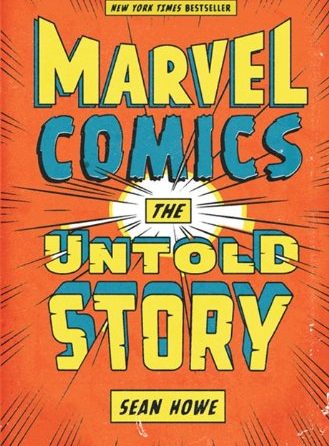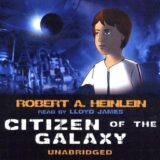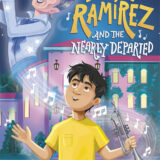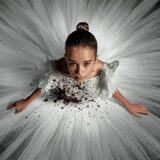
Is it possible for an SF Worldcon to be too big? That was the question floating in the air high above (and I mean HIGH above) the heads of 10,000+ of us as we made our way through the cavernous space that was the main floor of the Excel Convention Center at the Docklands, London. It’s a question I will get back to later – meanwhile I’ve decided that the only way to deal with a Worldcon of such proportions is to devote more than one blog to it. So there will be three of these posts (all good things come in threes, as you know). Because, when you’re attending the largest SF Worldcon in the history of Worldcon, there is just TOO much to see and do (and say about it) to squeeze into one teensy blog – even the kinds of teensy that I routinely publish here (already over the edge of what AS’s esteemed editor suggests as a reasonable length 🙂
Built for the Olympics, I was told, the Excel Center is a truly large venue: so big, that the building was one-third of a mile in length from the West to East Entrance, where the Worldcon was being held. I didn’t realize this until Thursday morning, one full day after I arrived (the first day I used to recoup from jet lag and went nowhere) and made the trek to Registration. When I say “trek” I mean it: It was so long a distance to walk, that – because my hotel was at the West entrance – I (and most others who were similarly staying at hotels near that entrance) were compelled to ride the DLR (Docklands Light Railway) trains for one stop each time we wanted to return to the con, or have dinner (all the nearby restaurants, it seemed, were located near the West Entrance).

Jumping on the train was easy thanks to “lifts” and covered walkways but . . . still alot of walking, in the midst of construction on this part of the line. I mention this only because the effort to get there was matched only by my surprise when I finally got to “Registration,” that first morning. OMG.
Despite having pre-registered, I estimate the line was 4 blocks long – winding for yards on the “boulevard level” and then up a long flight of steps to another line in the “first level”. Then I had to wait on a shorter line for program participants. I was tired of walking and standing by then – but the organization and orderliness of things was astounding. Registering . . . like my program packet and schedule . . . was error free. Even better – and against all odds – it turned out to be not so big a Worldcon after all. Somehow, everyone I wanted to see, was hoping to see, I magically found, in short order. In the art show, attending panels with me, or just hanging around the “fan village” – for “newbies” it may have been a wholly different experience, however.

THE meeting spot for everyone . . . thanks to tables and chairs and beer, was the “Fan Village.” No surprise, I suppose, given the camaraderie of those who look forward to seeing each other for these brief times, once or twice a year, over a period of 20-30 years. Yikes! 🙂
Naturally, my first stop was the art show. More than 100 artists, in a space 33 meters wide x 60 meters long, according to co-director of the artshow, Serena Culfeather. That made the display space close to 2/3 the size of a football field, or – as I discovered – too big to get through in one day. Especially when your first priority is to schmooze with artists you haven’t seen in years. This was worrisome, because I knew I was on the program to give a docent tour on Friday morning. So I took a few notes on about 1/3 of the show and figured that would be about all anyone could reasonably hear me jabber about for an hour. As it turned out, I was right.
The art show was buzzing: a combination of artists still setting up and people waiting impatiently for the TITAN art book launch at 4 PM . . . and artists’ signing. More about that in Part 2 of my Loncon3 report.

No surprise: the dearth of American artists represented in the artshow. No surprise: the fact that 50% of the art (estimated)
was digital art/prints. Big Surprise: the quality of the art (traditionally painted and new media) that was on display. Big surprise: the difference it can make when artists are given the space to show large works that don’t fit on 4’x6′ panels, such as John Harris‘s major triptych print of a painting in pastels, “Ancillary Justice,” or when tables holding 3D art aren’t relegated to the hinterlands, but rather intergrated into the heart of the exhibition area . . .

. . . as the photo here shows, with David Angus‘s “Exoearth” model front and center. These decisions elevated the 3D artwork and made a big difference (to me, at least) in how such art is perceived.
Among my stops: to say “hello again” to all the artists I knew – and see what they brought in. Jim Burns, still adjusting the bid sheets on his offerings of giclee prints on a large table, gave me a jolt – he was now sporting a beard (!) Bruce Pennington was there, too, and that was a pleasant surprise. I met for the first time at the World Fantasy convention in Brighton, England last year (though we had corresponded before then) – so I was happy to see that appearance had gone well enough for him to venture out again, thanks to his friend author Nigel Suckling (a name well known to fans of art books published by Paper Tiger). The £ to $ exchange rate was a real downer for me, escalating the prices beyond the comfort zone for me – or else I would have taken a few home! I spent too long with Danny Flynn and as it turned out, ended up introducing him to Pennington. I hurried to see what Harry Harrison’s estate (among others had put up for auction. It was advertised as vintage British illustration art, but it was a relatively sparse display, “odds and ends” and not what I was hoping for (what I was hoping for was to find some early 50s colorful UK mag covers, the kind that never seem to surface!) The good stuff by American artists (Van Dongen, Freas) quickly got bids.
Meanwhile, my first panel, me as moderator, was on Thursday at 7 PM. Ordinarily, I would despair at having a program item scheduled at that hour. But with 10,000 attendees – as I discovered – no worries about people not showing up. There were 14 (14!) program items to choose from at that hour, and the room was still pretty full. I had previously written everyone on the panel – the topic was “The Future of Professional Artists” – begging them, please,”let’s not make this discussion into a eulogy. . . bemoaning the “death” of sf art “as we knew it” 😉 And for the most part, we succeeded. . . no pity party for us!!! I knew everyone on the panel but one: Hugo Award Winner, 2013 for Best Fan artist, and also 2014 nominee for Best artist, Galen Dara, whom I met for the first time at this panel. What a treat! I wish I had taken her picture, she was dressed for cosplay with an attention getting headpiece of pink flowers and an adorable pinafore-type dress, shades of pink – a youthful ensemble that made the rest of us on the panel, Danny Flynn, Chris Moore, and Steve Crisp look totally joyless and decrepit. It made me think: why am I always wearing blouses guaranteed not to wrinkle? Maybe next year . . . purple hair . . . in Spokane?
After the panel “we” – joined by others attending the panel – repaired to the “Fan Village” for some expensive, warm beer and crisps (chips). We got so involved with yakking that by the time I realized the time, I was too tired to search for the auditorium where the retro Hugos award ceremony was being held – RATS! 🙁 Even though I wrote the article on artists working in 1938 that would have been potential contenders for the Award, had there been one. Next morning I learned that Finlay won. Hurrah! 🙂
Next post: more about art, new art books and artists!











1 Comment